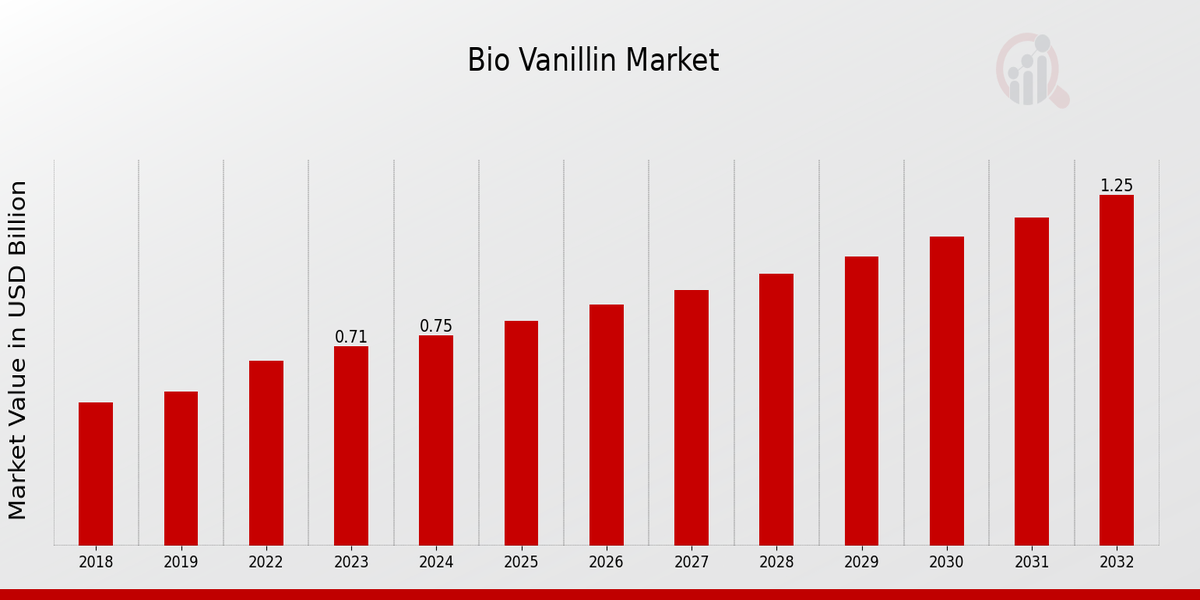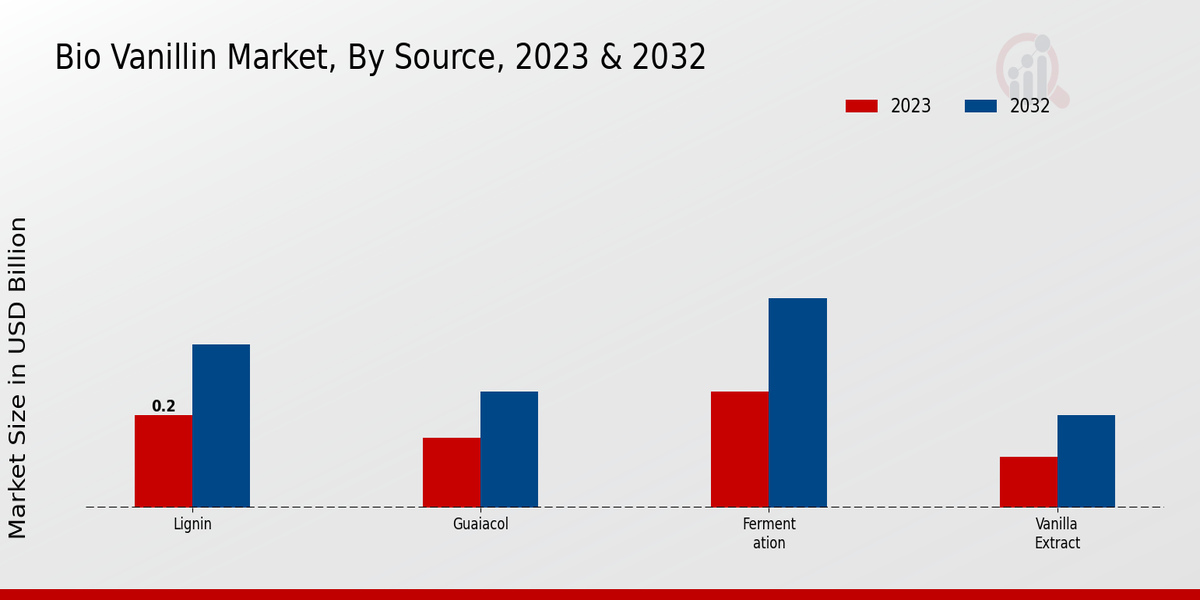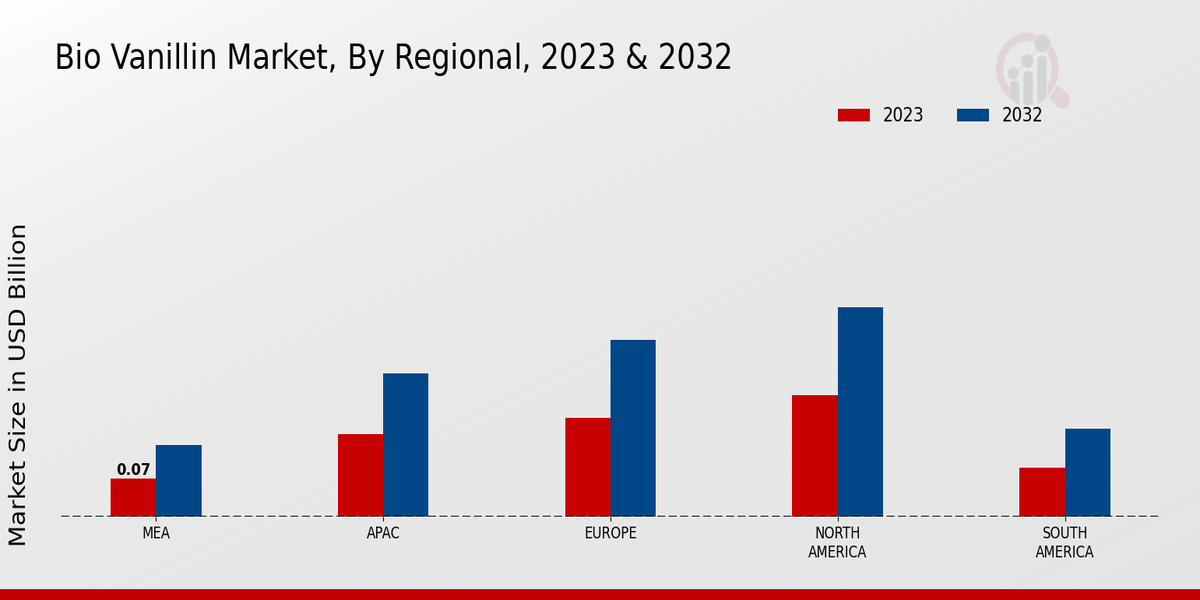Global Bio Vanillin Market Overview
Bio Vanillin Market Size was estimated at 0.66 (USD Billion) in 2022. The Bio Vanillin Market is expected to grow from 0.71(USD Billion) in 2023 to 1.25 (USD Billion) by 2032. The Bio Vanillin Market CAGR (growth rate) is expected to be around 6.52% during the forecast period (2024 - 2032).

Source Primary Research, Secondary Research, MRFR Database and Analyst Review
Key Bio Vanillin Market Trends Highlighted
The Bio Vanillin Market is experiencing significant growth driven by increasing consumer demand for natural and sustainable products. The rising awareness regarding health and environmental impacts associated with synthetic vanillin has prompted manufacturers to shift towards bio-based alternatives. This shift is particularly notable among food and beverage industries that emphasize clean labeling and natural ingredients. Furthermore, the expanding aromatherapy and fragrance sectors are also embracing bio vanillin for its eco-friendly profile, fueling its market attractiveness.
There are numerous opportunities waiting to be captured within the market, particularly in emerging economies where there's a growing consumer base keen on organic and natural products. Producers can explore collaborations with agricultural sectors for sourcing raw materials like lignin and guaiacol, which are key in bio-vanillin production. Additionally, innovations in extraction and synthesis techniques can enhance yield and lower production costs, thus broadening market accessibility.
Trends in recent times highlight a shift towards customizable and diversified vanillin products focused on various industry needs. The rising trend of health consciousness among consumers has sparked interest in segments such as plant-based food and premium desserts, leading to potential expansions in product offerings. Moreover, the integration of biotechnology to improve efficiency in bio vanillin production stands as a forward-thinking trend that may reshape the competitive landscape. As these dynamics evolve, stakeholders must remain agile to effectively leverage the changing sentiments and technology innovations within the bio vanillin sector.
Bio Vanillin Market Drivers
Rising Demand for Natural Flavoring Agents
The Bio Vanillin Market Industry is witnessing a significant shift in consumer preferences towards natural and organic products. As awareness of the potential health benefits associated with natural flavoring agents increases, the demand for bio vanillin is on the rise. Consumers are becoming more health-conscious and are looking for products that do not contain synthetic additives or artificial flavors. In sectors such as food and beverages, cosmetics, and pharmaceuticals, the use of natural bio vanillin has seen increased acceptance and integration.
Additionally, as regulatory bodies worldwide enforce stricter guidelines on synthetic flavoring agents, manufacturers are being compelled to seek out natural alternatives. This transformation is driving growth within the Bio Vanillin Market Industry as it aligns with the trend toward sustainability and natural product consumption. The ability of bio vanillin to provide the same desirable flavor profile as synthetic vanillin while being derived from natural sources makes it an attractive option for various industries.
As a result, producers and suppliers of bio vanillin are likely to experience heightened demand, leading to growth in the market.
Growing Applications in the Food & Beverage Sector
The Bio Vanillin Market Industry is benefitting significantly from its growing applications in the food and beverage sector. Vanillin, being one of the primary flavoring agents used in a variety of products, including baked goods, dairy, confectionery, and beverages, has seen an increase in demand. The ongoing innovation within this sector, focusing on clean-label products, has led to higher incorporation of bio-based ingredients. As manufacturers strive to meet consumer demands for transparency and quality, bio vanillin emerges as a suitable alternative due to its natural sourcing.
Sustainability and Eco-Friendly Production Processes
The Bio Vanillin Market Industry is also being driven by the increasing emphasis on sustainability and eco-friendly production processes. As industries across the globe are pressured to adopt sustainable practices, bio vanillin derived from renewable resources like lignin and guaiacol presents an appealing option. This shift reflects a broader trend toward reducing the carbon footprint and environmental impact of manufacturing processes. Consequently, companies are making concerted efforts to replace synthetic counterparts with sustainable alternatives, which fosters market growth and innovation in bio vanillin production.
Bio Vanillin Market Segment Insights
Bio Vanillin Market Source Insights
The Source segment of the Bio Vanillin Market shows promising growth potential, reflecting a robust revenue trajectory in the coming years. In 2023, the overall market is valued at 0.71 USD Billion, with significant contributions from various sources of bio vanillin production. The Lignin source, valued at 0.2 USD Billion in 2023, is expected to reach 0.35 USD Billion by 2032, which highlights its importance in the market due to its sustainable and renewable nature. Lignin, derived from plant biomass largely available as waste, plays a crucial role as it aligns with the growing trend towards sustainable practices and green chemistry in the food and fragrance industries.
Similarly, the Fermentation source, valued at 0.25 USD Billion in 2023 and projected to grow to 0.45 USD Billion by 2032, represents one of the most significant segments in the bio vanillin market. This process, using microorganisms to produce vanillin from natural substrates, reflects not only efficiency but also a method of leveraging biotechnology to meet consumer demands for natural flavorings and fragrances. Guaiacol, with a market valuation of 0.15 USD Billion in 2023 and growing to 0.25 USD Billion by 2032, also plays a significant role; it is derived from lignin or can be synthesized from petrochemicals, making it versatile in production methods. However, it is seen as relatively less dominant compared to Lignin and Fermentation due to its synthetic roots, despite its substantial applications across various industries.
Moreover, the Vanilla Extract source stands at 0.11 USD Billion in 2023, expected to reach 0.20 USD Billion by 2032, marking it as the least dominant within this segment. Despite its lower valuation, vanilla extract is crucial due to its premium status in culinary arts and its combination of traditional extraction processes with modern demands for natural ingredients. Overall, the Bio Vanillin Market segmentation demonstrates growing trends toward sustainable and renewable sources, with the Lignin and Fermentation segments dominating due to their scalability and alignment with consumer preferences for natural products. The increase in public awareness regarding sustainability and the health benefits of natural flavor compounds are significant growth drivers fueling this market segment, while challenges such as market volatility in raw material supply and quality control remain pertinent issues for all sources involved.

Source Primary Research, Secondary Research, MRFR Database and Analyst Review
Bio Vanillin Market Application Insights
The Bio Vanillin Market is projected to show robust growth with a valuation of 0.71 billion USD in 2023. The Application segment plays a pivotal role in this expansion, comprising areas such as Food & Beverages, Fragrance & Cosmetics, Pharmaceuticals, and Household Products. The Food & Beverages sector is particularly significant, driving high demand due to increasing consumer preference for natural flavoring agents. The Fragrance & Cosmetics area also prominently contributes to market dynamics, as natural ingredients gain traction among environmentally-conscious consumers.
In Pharmaceuticals, bio vanillin is valued for its potential therapeutic properties, while the Household Products category leverages its biocompatibility in formulations. Each application contributes to the comprehensive Bio Vanillin Market data, influencing trends, growth drivers, and overall market statistics. With a projected total market growth at a CAGR of 6.52 from 2024 to 2032, opportunities abound, reflecting the rising inclination towards natural alternatives across these applications. As industries evolve, the demand for eco-friendly and sustainable ingredients positions the Bio Vanillin Market industry for continued relevance and importance.
Bio Vanillin Market Form Insights
The Bio Vanillin Market, valued at 0.71 billion USD in 2023, encompasses various forms, including Powder, Liquid, and Crystal, each playing a pivotal role in the industry. The Powder form, often favored in the food and beverage sector, is known for its convenience and versatility, making it an essential choice among manufacturers. The Liquid form, prevalent in both culinary and fragrance applications, provides a concentrated option that caters to specific consumer preferences. Meanwhile, the Crystal form is recognized for its purity and high-quality profile, which is increasingly sought after in premium products.
The market shows a notable trend towards natural ingredients, spurring demand for bio-based vanillin due to its sustainable production methods. As consumers gravitate towards clean labels, the necessity for versatile and high-quality forms of bio vanillin becomes apparent, driving growth across the segmentation. However, challenges such as high production costs and market competition may impact the growth trajectory. Yet, the growing focus on eco-friendly products presents significant opportunities for market players, thereby influencing the overall Bio Vanillin Market statistics and growth dynamics.
Bio Vanillin Market End User Insights
The bio vanillin market, valued at approximately 0.71 billion USD in 2023, showcases diverse applications across various end users, including food manufacturers, cosmetic companies, pharmaceutical companies, and research institutions. Food manufacturers represent a significant portion of the market, capitalizing on bio vanillin's natural flavoring properties to enhance their products while meeting consumer demand for clean-label ingredients. Cosmetic companies utilize bio vanillin for its pleasant fragrance and antioxidant properties, making it a sought-after ingredient in beauty formulations.
Pharmaceutical companies also leverage bio vanillin in flavoring medicines, which is crucial for ensuring patient compliance, especially in pediatric medications. Research institutions play a vital role in the innovation and testing of bio vanillin, driving advancements in sustainable production methods and applications. The trends in the bio vanillin market highlight a growing shift towards natural and sustainable ingredients, driven by awareness of health and environmental concerns, which supports the growth trajectory for the sector.
The overall market dynamics suggest a robust expansion influenced by these end-user demands, demonstrating the vital interplay between bio vanillin applications and market growth factors.
Bio Vanillin Market Regional Insights
The Bio Vanillin Market is expected to experience notable growth across various regions, reflecting an overall valuation of 0.71 billion USD in 2023. North America represents a significant portion of the market, valued at 0.22 billion USD, exhibiting strong demand and consumer acceptance, while Europe follows closely with a valuation of 0.18 billion USD, driven by stringent regulations promoting natural ingredients. The Asia Pacific region, valued at 0.15 billion USD, is gaining traction due to rapid industrialization and growing interest in sustainable food products.
The Middle East and Africa segment holds a smaller share, valued at 0.07 billion USD, but shows opportunities for growth as awareness of bio-based products increases. Meanwhile, South America, valued at 0.09 billion USD, is also emerging with potential as demand for natural flavoring agents rises. This regional variation in the Bio Vanillin Market segmentation highlights the importance of regional consumer preferences, regulatory environments, and industrial capabilities, with North America and Europe dominating due to their established markets and consumer trends favoring sustainability.

Source Primary Research, Secondary Research, MRFR Database and Analyst Review
Bio Vanillin Market Key Players And Competitive Insights
The Bio Vanillin Market has witnessed substantial growth over the years, driven by increasing consumer demand for natural and sustainably sourced ingredients. As a crucial flavoring agent widely used in food, beverages, and fragrance applications, bio vanillin has emerged as a preferred alternative to synthetic vanillin due to its enhanced sensory attributes and eco-friendliness. Competitive insights in this market highlight the dynamic interplay between well-established players and new entrants, with innovation and sustainability becoming pivotal factors determining market share. Companies are investing heavily in research and development to enhance production efficiencies, reduce costs, and ensure compliance with regulatory standards, positioning themselves favorably for long-term success in the bio vanillin landscape. The competitive environment is characterized by strategic partnerships, mergers, and technological advancements, allowing firms to leverage their strengths in maximizing market penetration while responding to shifting consumer preferences.
Solvay stands out in the Bio Vanillin Market due to its strong commitment to sustainable practices combined with advanced chemical innovations. Its extensive experience in chemical manufacturing and focus on eco-friendly solutions have positioned Solvay as a leader in producing high-quality bio vanillin. The company benefits from its robust supply chain and presence, enabling it to distribute products efficiently across diverse regions. Furthermore, Solvay's dedication to innovation is reflected in its investment in cutting-edge technologies and processes that enhance production capabilities and optimize resource use. This commitment not only bolsters its market position but also supports its reputation for reliability and quality within the industry, catering to an expanding customer base seeking natural and safe ingredient alternatives.
On the other hand, Givaudan plays a prominent role in the Bio Vanillin Market by capitalizing on its extensive experience in flavor creation and a deep understanding of consumer preferences. Known for its innovative approach to flavor development, Givaudan has positioned itself as a key player in providing high-quality bio vanillin solutions that meet the growing demand for natural flavors. The company's robust research and development initiatives allow it to stay ahead of market trends and continuously enhance its product offerings. Givaudan's footprint and established customer relationships further amplify its competitiveness, as it can swiftly adapt to evolving market dynamics while maintaining strong partnerships with food and beverage manufacturers. Its dedication to sustainability and ethical sourcing principles reinforces its appeal in a market increasingly focused on environmentally responsible practices.
Key Companies in the Bio Vanillin Market Include
Bio Vanillin Market Industry Developments
Recent developments in the Bio Vanillin market reflect a growing trend towards sustainable and natural flavoring agents, driven by consumer demand for clean label products and environmentally friendly sourcing. Key players are increasingly investing in biotechnological advancements to enhance the production efficiency of bio-based vanillin, moving away from synthetic alternatives. Regulatory support for natural ingredients also plays a significant role in shaping market dynamics. Furthermore, strategic partnerships among industry stakeholders are being forged to expand production capabilities and distribution networks. The rising popularity of bio vanillin in the food and beverage industry, cosmetics, and pharmaceuticals illustrates its versatility and market potential. Recent research initiatives are focused on optimizing extraction and fermentation processes, contributing to growth projections. With the market expected to reach a valuation of USD 1.25 billion by 2032, the compound annual growth rate (CAGR) of 6.52% underscores the sustained interest and investment in this segment, indicating a robust trajectory ahead as companies adapt to evolving consumer preferences and regulatory landscapes.
Bio Vanillin Market Segmentation Insights
Bio Vanillin Market Source Outlook
Lignin
Fermentation
Guaiacol
Vanilla Extract
Bio Vanillin Market Application Outlook
Food & Beverages
Fragrance & Cosmetics
Pharmaceuticals
Household Products
Bio Vanillin Market Form Outlook
Powder
Liquid
Crystal
Bio Vanillin Market End User Outlook
Food Manufacturers
Cosmetic Companies
Pharmaceutical Companies
Research Institutions
Bio Vanillin Market Regional Outlook
North America
Europe
South America
Asia Pacific
Middle East and Africa
| Report Attribute/Metric |
Details |
| Market Size 2022 |
0.66(USD Billion) |
| Market Size 2023 |
0.71(USD Billion) |
| Market Size 2032 |
1.25(USD Billion) |
| Compound Annual Growth Rate (CAGR) |
6.52% (2024 - 2032) |
| Report Coverage |
Revenue Forecast, Competitive Landscape, Growth Factors, and Trends |
| Base Year |
2023 |
| Market Forecast Period |
2024 - 2032 |
| Historical Data |
2019 - 2023 |
| Market Forecast Units |
USD Billion |
| Key Companies Profiled |
Solvay, Givaudan, Green Biologics, Genomatica, BASF, Sensient Technologies, International Flavors Fragrances, Vanilla Food Company, Vigon International, Advanced Biochemical, Austrianova, Kerry Group, Firmenich, Frutarom, Symrise |
| Segments Covered |
Source, Application, Form, End User, Regional |
| Key Market Opportunities |
Growing demand for natural flavors Expanding food and beverage sector Rising consumer health consciousness Sustainable product preferences Increasing applications in fragrances |
| Key Market Dynamics |
Rising demand for natural flavors Growing vegan and plant-based trends Increased investment in R&D Regulatory support for biobased products Expanding application in food industries |
| Countries Covered |
North America, Europe, APAC, South America, MEA |
Frequently Asked Questions (FAQ) :
The Bio Vanillin Market is expected to be valued at 1.25 USD Billion by 2032.
The expected CAGR for the Bio Vanillin Market from 2024 to 2032 is 6.52.
North America is projected to hold the largest market share with a valuation of 0.38 USD Billion by 2032.
The Fermentation segment is expected to be valued at 0.45 USD Billion by 2032.
Major players in the market include companies like Solvay, Givaudan, and BASF.
The Lignin segment is anticipated to reach a market size of 0.35 USD Billion by 2032.
The market size for the APAC region is expected to be valued at 0.26 USD Billion by 2032.
The Guaiacol segment is projected to have a market size of 0.25 USD Billion by 2032.
The Vanilla Extract segment is expected to be valued at 0.20 USD Billion by 2032.
The market size for South America is projected to reach 0.16 USD Billion by 2032.
















